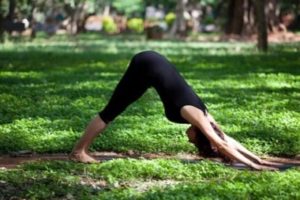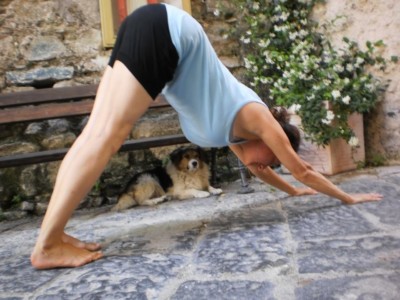How to practice downward dog safely as a beginner or practitioner is crucial to avoid injuries and wrist pain. The pose itself can be challenging, especially if you are stiff around your shoulders and hamstrings. It might look easy but it’s actually quite a complex pose.
If you are a beginner
If you’re a yoga beginner downward dog might not feel as blissful as it looks like. However, don’t give up! Downward dog builds strong bones and provides a great ankle, hamstring and calf stretch. Most people are tight in those three areas, especially those with desk jobs, long hours standing on a hard surface, runners, climbers and fitness practitioners.
The great thing about downward dog is that it targets your upper and lower body at the same time. When you practice downward dog, never stress about the fact that your heels aren’t touching the mat. It doesn’t matter. What matters when you practice this yoga pose is:
1. Always have your hands firmly grounded to the earth. Spread your fingers wide and use your whole hand, pressing it onto the mat.
2. Always have your feet hip distance apart.
3. Bring all your weight back towards your heels, not into your shoulders, arms and wrists.
4. Bend your knees if your hamstrings are tight. This is much better for your spine rather than forcing the heels down to the earth.
5. Firm your shoulder blades and role them back, feeling them draw towards the tailbone.
6. Be mindful. Go at your pace. Never push or force this stretch. With time you build strength in your shoulders, wrists, arms and legs.
7. Breathe deeply and do as much as you can. After all, it’s just Yoga. There is no such thing as the perfect yoga pose. Don’t stress about that. Focus on how good it feels in your body after class when you’re completely stretched, relaxed and uplifted.

When to skip the downward dog
If your shoulders are tight or you feel an accumulation of stress around your neck, shoulders and upper back, avoid the practice of downward dog. Sometimes this pose feels more tiring than relaxing. If it feels like an effort than actual bliss go a little slower. Check in with yourself before your Yoga class. How are you feeling physically and mentally? Do you feel exhausted? If so, then take rest during your class and skip the downward dog. If you feel pain in your wrists or shoulders then back off a bit and reduce the practice of this pose.
Know your limits, and be mindful of yourself. You body knows when something feels right or wrong. Remember, that with time this pose will feel easy and light to practice. Like with so many other things in life – have patience and acceptance, it is the only way forward, also in your Yoga practice.

